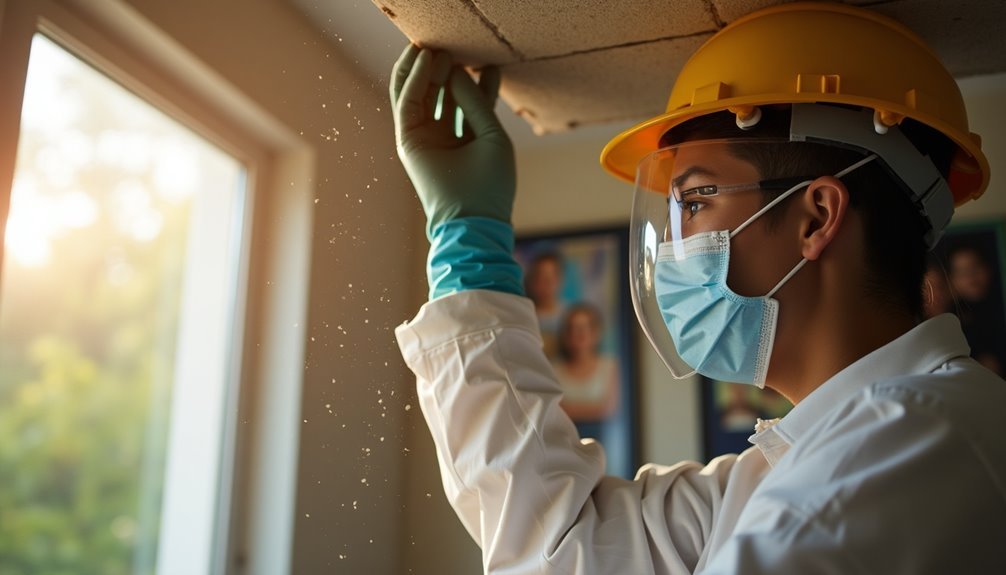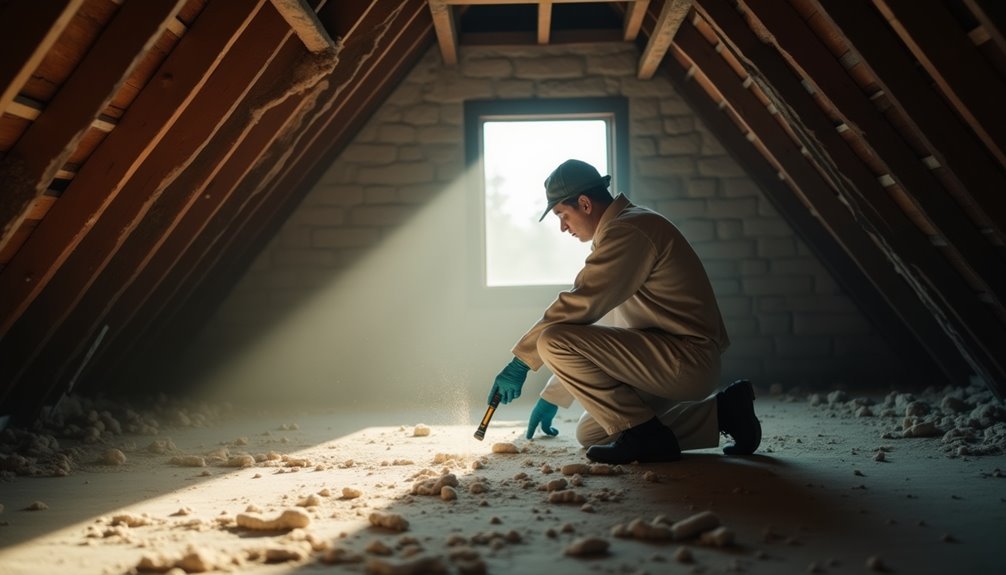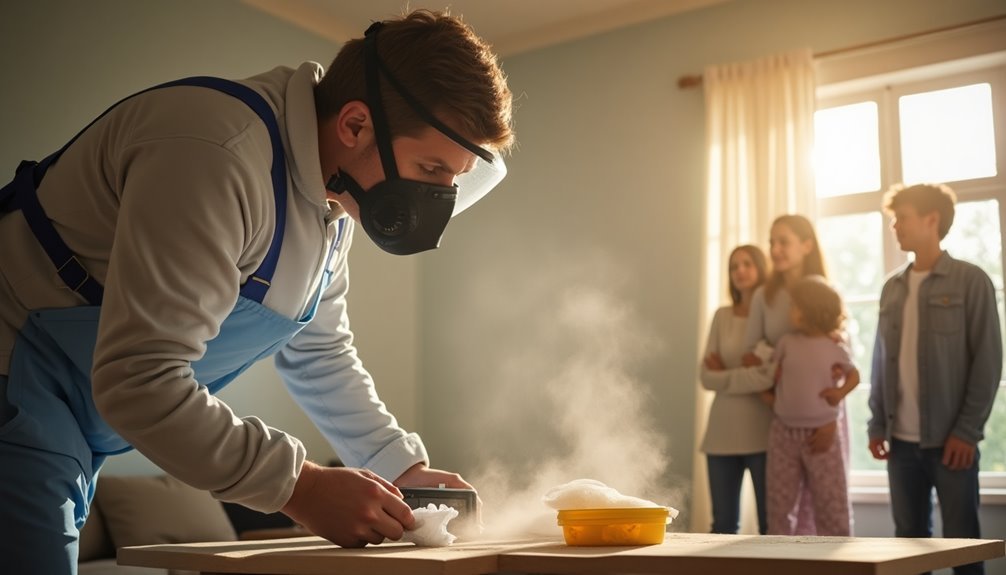During an asbestos inspection, a qualified inspector evaluates your property for hazardous materials, focusing on areas likely to contain asbestos, like insulation and roofing. They review your home's construction history, conduct visual inspections, and collect samples for laboratory analysis. This process is crucial because asbestos exposure can lead to serious health issues, including lung cancer and asbestosis, often years later. By identifying potential risks, you can take necessary actions to protect your family's health. Understanding the steps involved can further inform your approach to ensuring a safe living environment.
Importance of Asbestos Inspections

Asbestos inspections are crucial for ensuring safety and compliance, with regulations mandated by federal and state authorities like OSHA and the US EPA. By prioritizing asbestos awareness, you're not just adhering to the law; you're actively protecting your family and community from severe health risks associated with asbestos exposure. These inspections are essential in construction and renovation projects, where many building departments will refuse to issue permits without a completed asbestos survey. This proactive approach not only safeguards your health but also prevents unexpected costs and delays during renovations. When you invest in a thorough inspection, you're practicing due diligence, particularly in commercial real estate transactions, where undiscovered asbestos can lead to serious financial repercussions. Moreover, independent inspection firms play a critical role by providing unbiased results, ensuring that you're fully aware of any risks present. Regular monitoring of asbestos materials is essential to maintain a safe environment, thereby taking vital steps to protect your family from potential long-term health issues related to asbestos exposure.
Initial Assessment Process
When you begin the initial assessment process for asbestos, start by reviewing the property's construction history to pinpoint when asbestos was likely used. Next, conduct interviews with current and former occupants, as well as maintenance staff, to gather insights on the materials in the building. Finally, perform a visual inspection of accessible areas to identify any potential asbestos-containing materials (ACMs). It is crucial to recognize that asbestos is a group of six naturally occurring fibrous minerals that may still be present in older buildings.
Historical Property Review
Conducting a historical property review is crucial for identifying probable asbestos-containing materials (ACM) before diving into a detailed inspection. This initial assessment focuses on understanding the property's historical significance and its construction materials, helping you pinpoint where asbestos might be lurking.
To start, you'll review historical documents, building plans, and past inspection reports. By examining these records, you can gain insights into the types of construction materials used and identify common ACM associated with different periods. Pay close attention to areas where asbestos was typically employed, such as insulation, roofing, and flooring.
Look for materials like pipe insulation, ceiling tiles, and wallboards, and check around heating and cooling systems. Don't overlook the exterior, as siding and window caulks may also contain asbestos. Document all findings meticulously to support future inspections and risk assessments.
Finally, create a detailed inspection plan based on your review, mapping out suspected ACM locations for sampling. This proactive approach not only safeguards your family's health but also empowers you with knowledge about your property's past.
Occupant Interviews
After completing a historical property review, it's time to gather insights directly from those who know the building best—its occupants. Conducting occupant interviews allows you to tap into valuable experiences and knowledge that can significantly inform the asbestos inspection process. Qualified inspectors engage with current and former occupants, maintenance staff, and contractors using targeted interview techniques.
These discussions focus on past renovations, maintenance activities, and known asbestos-containing areas. You'll uncover crucial information about where asbestos might have been used or disturbed over the years. The interviews help identify rooms, floors, or hidden spaces like crawl spaces and attics, where asbestos may be present.
Visual Inspection Techniques
Visual inspection techniques play a crucial role in the initial assessment process for identifying potential asbestos-containing materials (ACMs) within a building. As you begin the inspection, consider the building's age and history, as this information can shed light on the likelihood of asbestos use during construction. Focus on common locations where ACMs are typically found, such as insulation, floor tiles, and roofing materials.
Look for visual indicators like fibrous material, wavy patterns, and chalky textures, which can signal the presence of asbestos. Conduct a detailed examination of material conditions, checking for damage or degradation that might release harmful fibers. Don't overlook hard-to-reach areas; utilize appropriate equipment to access these spaces safely.
As you identify suspect materials, be mindful of asbestos siding and thermal system insulation. Document your findings meticulously, as this will aid in risk assessment and future reference. Through these thorough inspection techniques, you can prioritize areas that pose the highest risk, ensuring that your family's health remains protected from potential asbestos exposure.
Physical Inspection Steps

A thorough physical inspection of a building is essential to identify potential asbestos hazards that could impact family health. This process begins with an initial assessment, where you review the building's history and identify areas likely containing asbestos. Engaging with occupants and maintenance staff can provide valuable insights, while examining accessible areas helps shape a detailed inspection plan.
As you proceed, a visual examination is crucial. You'll look for signs of damage, such as tears or abrasions in materials, using various inspection tools like screwdrivers and chisels to access hard-to-reach spots. Documenting your findings is vital for future risk assessments.
Next, assess the condition of the materials. This includes checking for moisture content, which can lead to deterioration and increase the risk of asbestos fiber release. Evaluate the exposure to elements like vibration or airflow that may contribute to damage. Grading the material condition helps determine necessary actions—whether it requires repair, encapsulation, or removal.
Lastly, prepare detailed documentation outlining your damage assessment and recommendations, ensuring you adhere to relevant regulations. This comprehensive approach empowers you to safeguard your family's health effectively.
Sampling and Laboratory Analysis
Once you've completed the physical inspection, the next step involves sampling and laboratory analysis to confirm the presence of asbestos. Certified inspectors collect samples from materials suspected of containing asbestos, like insulation, tiles, and popcorn ceilings. They focus on potential "hot spots" and take small, representative samples to minimize disturbance. This process requires professional expertise to prevent unnecessary exposure to asbestos.
For sampling techniques, inspectors may use specialized sampling pumps, capable of varying flow rates, to collect air samples efficiently. Filters capture airborne asbestos fibers, ensuring accurate results. Sampling times are adjusted based on the environment to optimize fiber loading on the filters.
In the laboratory, methods like Polarized Light Microscopy (PLM) play a crucial role in detecting asbestos in bulk samples. Transmission Electron Microscopy (TEM) may also be utilized to complement PLM results, providing a detailed analysis of fiber types and percentages. Accurate reporting of these findings is essential, helping you understand any hidden health hazards and informing future remediation efforts. This meticulous process empowers you to take control of your family's health, ensuring a safer living environment.
Post-Inspection Recommendations

After your asbestos inspection, it's crucial to follow the inspector's recommendations for operation and maintenance (O&M) strategies. If hazardous materials are identified, you'll need to decide whether to repair or remove them based on their condition. Implementing these strategies not only ensures compliance with safety regulations but also protects your family's health.
O&M Strategies
Regular monitoring and maintenance of asbestos-containing materials (ACMs) are crucial for ensuring safety in environments where these materials are present. Implementing effective monitoring programs helps you keep an eye on the condition of ACMs, allowing you to identify any deterioration early. Schedule periodic re-inspections, especially if ACMs were identified in your initial inspection, to ensure ongoing compliance and safety.
It's essential to maintain detailed records of the location and condition of ACMs, as well as any changes made. Ensure that all maintenance personnel are adequately trained to handle ACMs safely, employing best practices during maintenance procedures to prevent accidental damage.
If you discover slightly damaged ACMs, consider repair options like sealing or covering them to minimize fiber release. Always hire trained asbestos professionals for any repair work, and conduct post-repair checks to confirm the area is clean and safe.
Encapsulation can be a viable option for preventing fiber release from less severely damaged materials, so monitor the effectiveness of any sealants used. Finally, update your asbestos management plan regularly to reflect all monitoring, maintenance, and repair activities, ensuring that your home remains safe for your family.
Hazardous Material Removal
When asbestos is confirmed in your home, it's crucial to act swiftly and implement a comprehensive removal plan to protect your family's health. Start by ensuring that all areas contaminated with asbestos are clearly marked and isolated. It's essential to evacuate everyone from the premises, including pets, to prevent exposure during the removal process.
Next, prepare the affected areas by sealing them off with heavy-duty barriers to contain any hazardous waste. Wetting agents can be applied to the asbestos materials to minimize airborne fibers, ensuring a safer environment for the workers handling the removal.
During the removal, asbestos materials should be either sealed if the contamination is minor or physically removed if necessary. Specialists will use specialized tools to cut out asbestos while keeping it wet to prevent dispersal. Once removed, the asbestos is stored in durable, air-tight bags for safe disposal.
Finally, ensure that the asbestos is taken to a certified landfill where it can be buried securely. This meticulous approach to hazardous material removal not only safeguards your home but also liberates your family from the risks associated with asbestos exposure.
Health Risks of Asbestos Exposure
Asbestos exposure poses significant health risks, affecting not only those directly exposed but also their families and communities. When you come into contact with asbestos, you increase your risk of developing serious asbestos diseases, including lung cancer and mesothelioma, both of which can be fatal. These cancers often take decades to manifest, typically appearing 20 to 50 years after initial exposure.
Asbestos exposure can also lead to asbestosis, a debilitating condition that causes scar-like tissue to build up in your lungs, impairing oxygen supply. Additionally, you may face cancer risks for other organs, including the pharynx, larynx, and stomach. If you smoke, the combined effects of tobacco and asbestos dramatically heighten your risk of lung cancer.
Symptoms of asbestos-related diseases often remain hidden for years, making early diagnosis challenging. Persistent coughing, shortness of breath, and respiratory issues may eventually arise, serving as alarming indicators of long-term exposure. Even family members of asbestos workers or those living near asbestos sites are at risk, underscoring the importance of vigilance regarding asbestos in your environment. Prioritizing health means addressing these risks proactively.
Regulatory and Legal Requirements

Understanding the health risks associated with asbestos exposure highlights the necessity for stringent regulatory and legal requirements surrounding asbestos inspections. Federal and state regulations, like 40 CFR Part 763 and SCAQMD Rule 1403, mandate thorough inspections before any demolition or renovation. These regulations ensure regulatory compliance, protecting both workers and families from hazardous exposure.
Qualified personnel, such as Cal/OSHA Certified Asbestos Consultants, must conduct these inspections. Their expertise is crucial in identifying and analyzing asbestos-containing materials (ACM). The law also requires a conflict-free relationship between inspectors and the projects they assess, ensuring unbiased evaluations.
The inspection process is comprehensive, covering all construction materials, and includes sampling of suspect materials for laboratory analysis. This rigorous approach not only identifies existing asbestos contamination but also outlines necessary remediation steps.
Finally, the Asbestos Survey Report must detail the inspection scope, findings, and include certified documentation. This report serves as a legal record, fulfilling regulatory requirements and protecting you from potential legal implications in the future. By adhering to these standards, you safeguard your family's health and well-being, ensuring a safe living environment.
Conclusion
In conclusion, scheduling an asbestos inspection is a crucial step in safeguarding your family's health. You might think it's unnecessary if your home seems fine, but asbestos can lurk undetected. By identifying and addressing any issues, you protect your loved ones from serious health risks. Remember, the peace of mind that comes from knowing your environment is safe far outweighs the temporary inconvenience of an inspection. Take action now to ensure a healthier future for your family.
